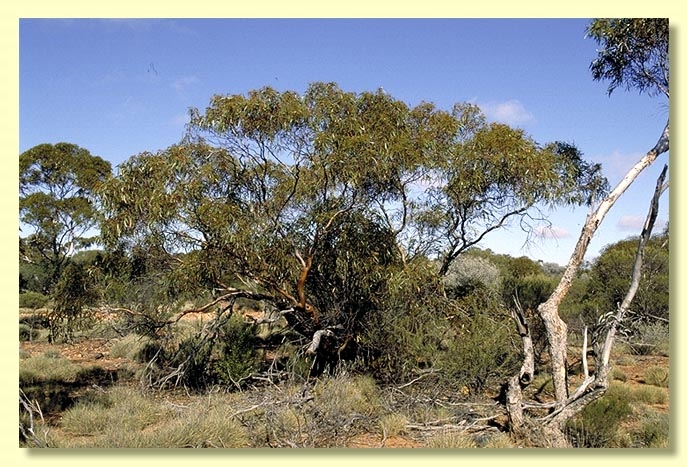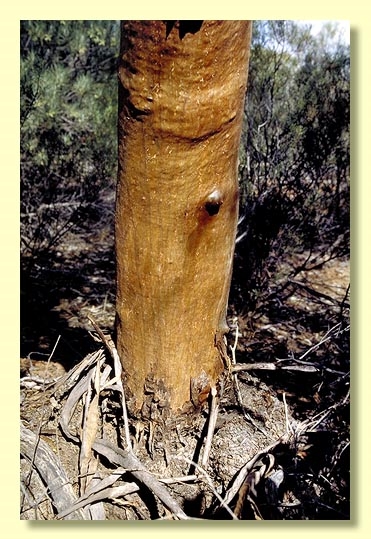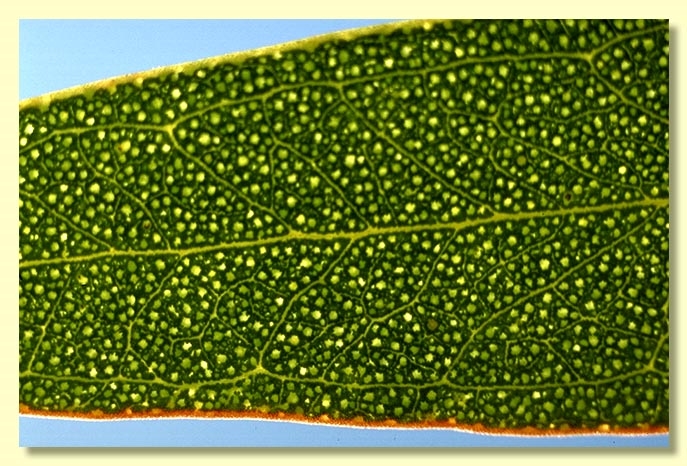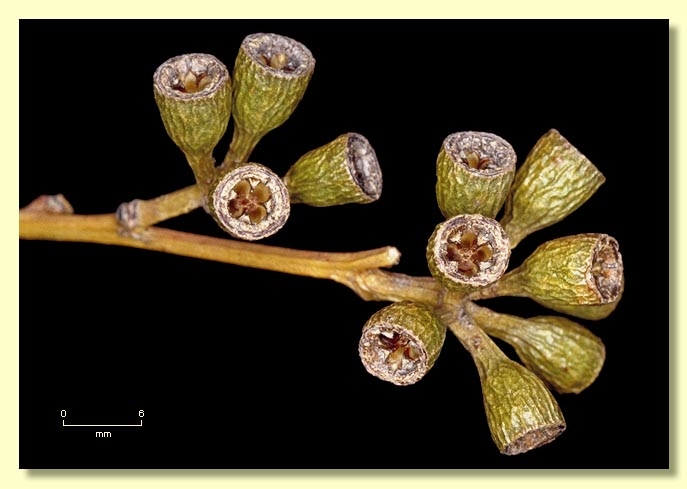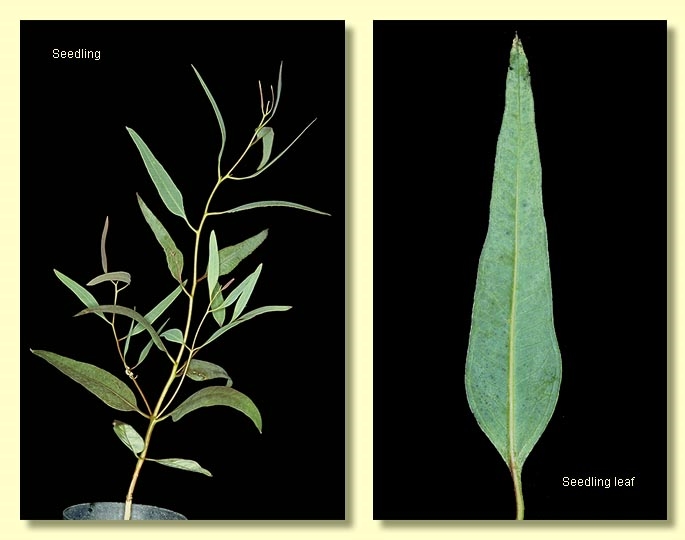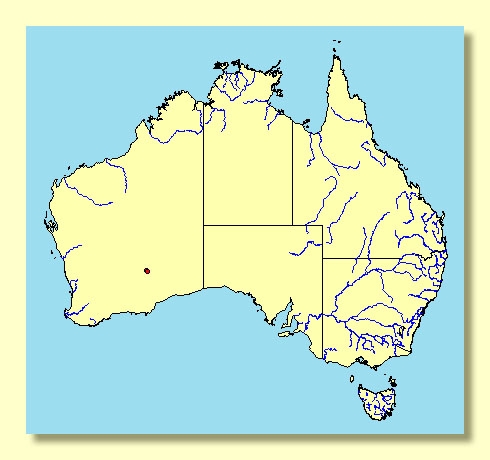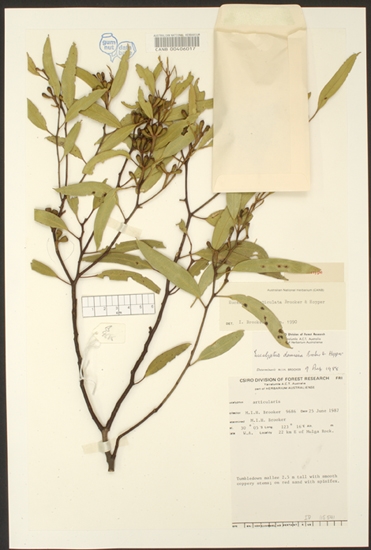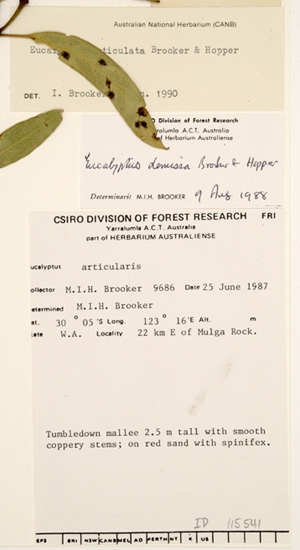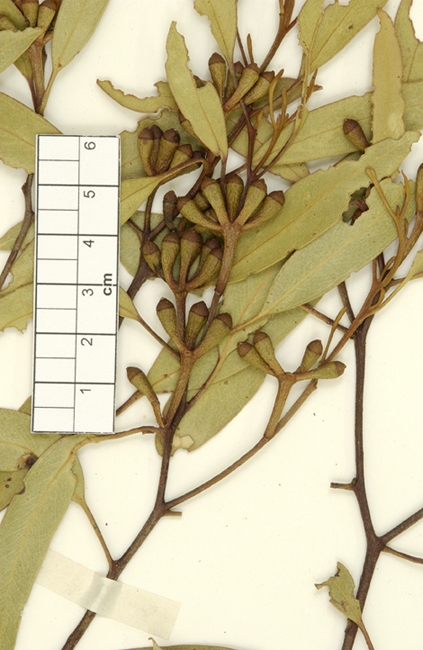Eucalyptus | Symphyomyrtus | Bisectae | Glandulosae | Loxophlebae
Euclid - Online edition
Eucalyptus articulata
Bark smooth throughout, coppery or bronze.
Branchlets with oil glands in the pith.
Juvenile growth (coppice or field seedlings to 50 cm): stems rounded in cross-section; juvenile leaves always petiolate, opposite for few nodes then alternate, broadly lanceolate, 6–12 cm long, 1–1.5 cm wide, dull, blue-green (non-glaucous).
Adult leaves alternate, petioles 0.8–1.8 cm long; blade lanceolate, 6–12 cm long, 1–1.5 cm wide, base tapering to petiole, margin entire, apex acute, concolorous, glossy, dark green, side-veins acute, reticulation sparse to moderate, intramarginal vein remote from margin, oil glands numerous, island, irregular.
Inflorescence axillary unbranched, or at times apparently terminal due to loss of apical vegetative bud, peduncles flattened, 0.5–1.5 cm long, buds 7 per umbel, stoutly pedicellate (pedicels (0.2)0.4–0.6 cm long). Mature buds obovoid to pyriform (0.7–0.9 cm long, 0.3–0.5 cm wide), scar present, operculum rounded and sometimes apiculate or bluntly conical, stamens inflexed with their filaments geniculate, anthers cuboid, versatile, sub-basifixed, dehiscing by longitudinal slits, style long and straight, the base tapering and articulate in a pit in the ovary roof, stigma blunt to rounded, locules 3 or 4, the placentae each with 4 vertical rows of ovules. Flowers white.
Fruit pedicellate (pedicels 0.2–0.7 cm long), obconical or at times almost cylindrical, 0.7–0.9 cm long, 0.4–0.7 cm wide, disc descending vertically, valves 3 or 4, enclosed to near rim level.
Seeds brown, 0.7–1.5 mm long, ovoid to flattened-ovoid or cuboid but scarcely angular, dorsal surface shallowly reticulate, hilum ventral.
Cultivated seedlings (measured at ca node 10): cotyledons Y-shaped (bisected); stems rounded in cross-section; leaves always petiolate, opposite for 3 to 6 nodes, lanceolate, 5–10 cm long, 1.2–3 cm wide, green, slightly glossy.
Flowering has been recorded in July.
A low straggly mallee endemic to Western Australia, known only from near Mulga Rock, north-east of Kalgoorlie, where it occurs on red sand dunes with arkose rubble. The bark is smooth, bright coppery in season, and the adult leaves are very glossy green with sparse venation and conspicuous oil glands.
Eucalyptus articulata belongs to Eucalyptus subgenus Symphyomyrtus section Bisectae subsection Glandulosae because the cotyledons are bisected, buds have an operculum scar and the branchlets have oil glands in the pith. Within this subsection E. articulata belongs to a small subgroup of four species, series Loxophlebae, further characterised by having buds with fully inflexed stamens with the filaments geniculate or strongly elbowed and a style that tapers basally, sparsely reticulate glossy green adult leaves and small obconical fruit. The four species are E. loxophleba (with four subspecies), E. blaxellii, E. articulata and from Mary Mia, north-east of Meekatharra, E. semota.
E. articulata is unlikely to be confused with any other species within its natural range. Its geographically closest relative is the smooth-barked E. loxophleba subsp. lissophloia, which is distinguished from E. articulata by having glaucous branchlets and glaucous, more or less deltoid juvenile leaves. E. articulata has blue-green (non-glaucous) lanceolate juvenile leaves and non-glaucous branchlets. The style base of E. articulata is jointed (articulate) where it inserts into a pit in the ovary roof, a character absent from E. loxophleba, but present also in E. semota and E. blaxellii.
Eucalyptus articulata is listed as "Vulnerable" under the Australian Government Environment Protection and Biodiversity Conservation Act 1999 (EPBC Act). Further information may be found at this web address:
http://www.environment.gov.au/cgi-bin/sprat/public/sprat.pl

